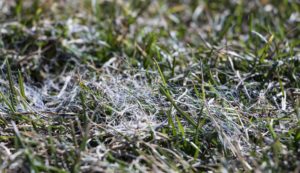
Learn what you can do to avoid the unsightly appearance of snow mold on your lawn.
When the snow melts off your lawn and leaves behind gray or pink patches, your yard could have snow mold. Snow mold is a fungus that can affect grass after a significant snowfall. While it is unsightly, this is not a destructive and unstoppable lawn problem. The following information can help you learn more about snow mold and what you can do to protect your landscape from it.
What Is Snow Mold?
This type of “mold” is a lawn disease caused by a fungal pathogen and can show symptoms on the grass as snow melts. As temperatures warm during or after winter, you might see the mold itself or straw-colored spots of dead grass. The fungal spores live in the soil year-round and only show themselves when the right environmental conditions allow them to. Once the temperature reaches between 32- and 45-degrees Fahrenheit and melting snow reaches the soil, the spores can begin to sprout.
There are two types of snow molds: pink and gray. Pink is the more severe variety, as it can kill grassroots and blades and continue to spread in temperatures as high as 60 degrees.
How to Help Prevent Mold From Showing Up
The key to avoiding snow mold damage is prevention. To help prevent mold from appearing, remember these tips:
- Consider bagging your clippings the last time you mow in the fall so they don’t trap excess moisture at the soil surface.
- Apply a preventable fungicide.
- Dethatch your lawn twice a year.
- Make sure your yard has proper drainage. Anywhere water pools can create a breeding ground for snow mold.
- Do not let wet leaves or snow accumulate. Anything that traps moisture is bad for your grass. After a snowfall, try not to create large piles of snow when shoveling your driveway.
What To Do If Mold Appears
If you spot snow mold, there is not much you can do right away. However, you can gently rake the area to loosen up matted grass and allow the soil to dry faster. Once temperatures rise and the soil starts to dry out, you can tell how your grass was affected. Remember that gray snow mold does not affect the roots, so your grass may bounce back. If you spot pink mold, rake away dead grass, and reseed any bare patches. After that, you can get your lawn back to its beautiful former appearance.
Scientific Plant Service Is Your Go-To Source In Landscape Healthcare
Scientific Plant Service, located in Baltimore, is a privately owned corporation, chartered in Maryland in 1957 by Frank J. Burke. We started as a full-service Arborists specializing in the care of shade trees and ornamental shrubs, but today we are a Lawn Care company that is a huge part of the community. From aquatic environments and snow management to deer and mole control, SPS has services tailored specifically for your lawn and landscape.
We offer services in Maryland, Washington, DC, and Virginia, including: Harford, Baltimore, Carroll, Frederick, Howard, Anne Arundel, Montgomery, Prince Georges, Talbot, Queen Anne’s, Calvert counties in MD, as well as Loudoun County, Fairfax County, Arlington, Alexandria, and Falls Church in VA. For more information, contact us online, or call us at 410-321-0970. Be sure to follow us on Facebook, Twitter, LinkedIn, and Pinterest.

